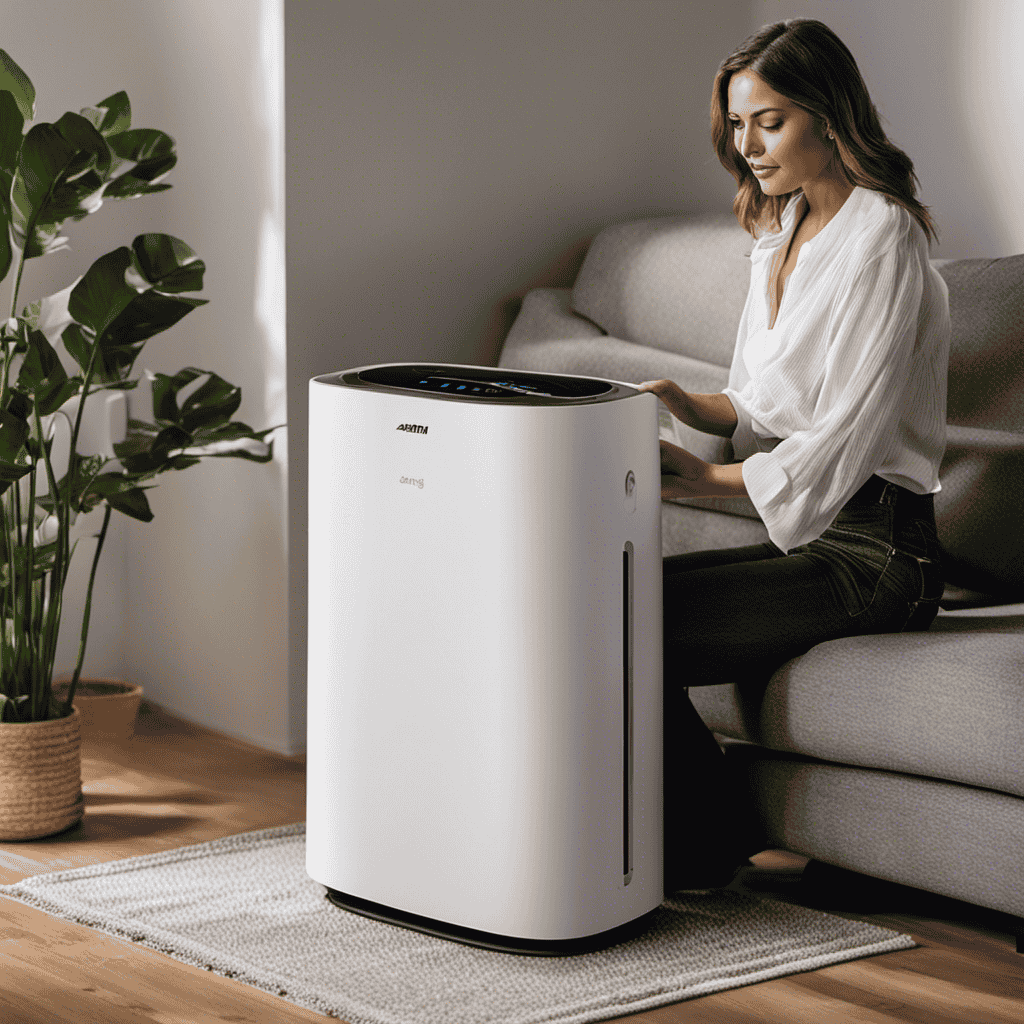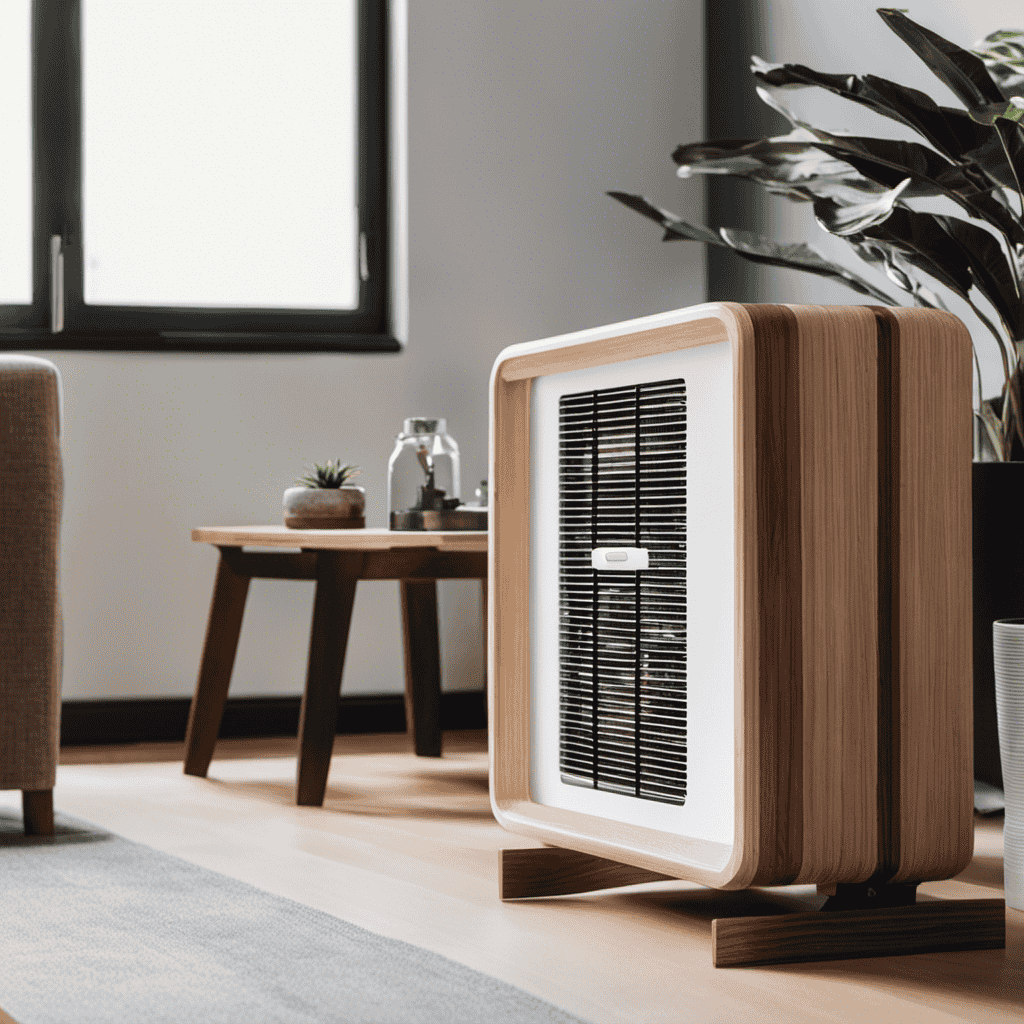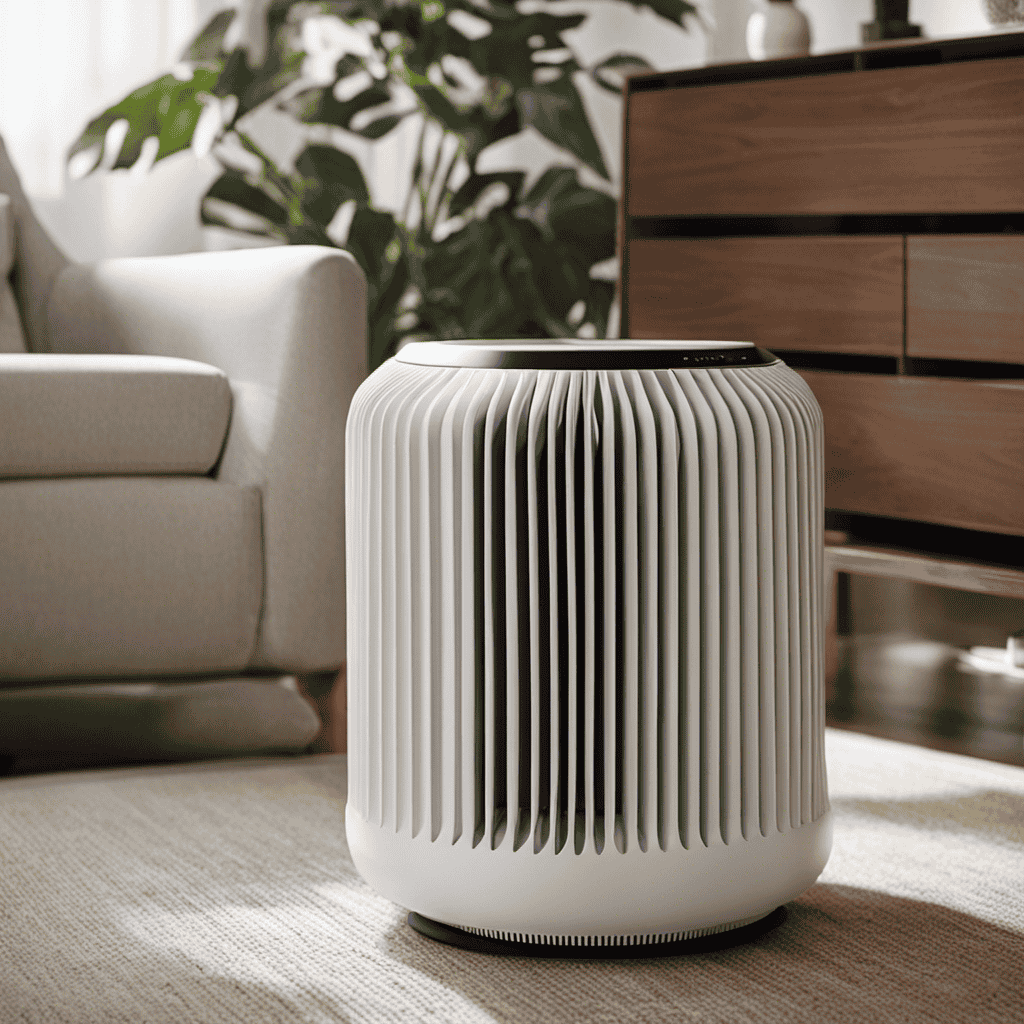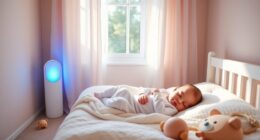Are you aware that indoor air can be up to five times more polluted than outdoor air? With the growing concerns about air quality, more and more people are opting for air purifiers to promote a healthier living space.
In this article, I will guide you through the process of using an air purifier effectively. From choosing the right one to understanding its filters and operating modes, I will provide you with the knowledge you need to breathe cleaner, fresher air in your home.
Key Takeaways
- Choose an air purifier with the appropriate capacity and coverage area for the size of the room.
- Consider the type of filters used in the air purifier, such as HEPA filters for allergens and activated carbon filters for odors.
- Establish a filter replacement schedule and regularly clean pre-filters to maintain optimal efficiency.
- Properly place the air purifier in a room, away from restricted airflow and strong odors, for maximum effectiveness.
Choosing the Right Air Purifier
When choosing the right air purifier, it’s important to consider the size of the room you want to purify. The size of the room will determine the capacity and effectiveness of the air purifier.
Air purifiers come in different sizes and have varying features to cater to different room sizes. For smaller rooms, a compact air purifier with a lower Clean Air Delivery Rate (CADR) may be sufficient. However, for larger rooms, it is advisable to choose an air purifier with a higher CADR and a larger coverage area.
Additionally, consider other features such as the type of filters used, noise level, and energy efficiency. It’s also important to check if the air purifier has a filter replacement indicator to ensure optimal performance.
Understanding Air Purifier Filters
When it comes to air purifiers, understanding the different types of filters is crucial. There are various filter options available, such as HEPA filters for capturing small particles, activated carbon filters for removing odors, and UV filters for killing bacteria and viruses.
Additionally, knowing the recommended filter replacement frequency and following proper maintenance tips will ensure that your air purifier continues to provide clean and healthy air for you and your family.
Types of Filters
To effectively use your air purifier, you’ll need to understand the different types of filters available. There are several options to choose from, each with its own advantages and effectiveness in removing pollutants from the air. Let’s compare the effectiveness of different filter options in the table below:
| Filter Type | Effectiveness |
|---|---|
| HEPA Filters | Highly effective in capturing allergens, dust, and other particles |
| Activated Carbon | Excellent at removing odors, gases, and chemicals |
| Ionizers | Generate negative ions to attract and neutralize pollutants |
| UV Filters | Kill bacteria, viruses, and mold spores with UV light |
| Pre-filters | Capture larger particles and prolong the lifespan of main filters |
Filter Replacement Frequency
Make sure you regularly check the filter replacement frequency of your air purifier to ensure it continues to effectively remove pollutants from your indoor air. Neglecting to replace the filter on time can result in reduced air purifying efficiency and compromised air quality.
To help you stay on top of filter replacements, here are some important points to consider:
-
Establish a filter replacement schedule: Determine how frequently your air purifier’s filter needs to be replaced based on the manufacturer’s recommendations. This can vary depending on factors such as the type of filter, air quality, and usage.
-
Monitor filter lifespan: Keep track of the filter’s lifespan by marking the installation date or using a filter replacement indicator if your air purifier has one.
-
Extend filter lifespan: Regularly clean pre-filters or washable filters if applicable, as this can help extend the lifespan of the main filter.
-
Purchase replacement filters in advance: To ensure you have a new filter ready when it’s time to replace, it’s a good idea to purchase replacement filters ahead of time.
Filter Maintenance Tips
Regularly cleaning and replacing the filter will help maintain the efficiency of your air purifier. The filter is a crucial component that traps pollutants and particles, ensuring the air you breathe is clean and healthy. Neglecting filter maintenance can lead to reduced airflow, decreased purification efficiency, and even potential damage to the unit. To emphasize the importance of filter maintenance, here are some key techniques to keep in mind:
| Filter Maintenance Tips | Importance | Cleaning Techniques |
|---|---|---|
| Check filter regularly | Ensures optimal efficiency | Vacuuming or washing |
| Replace filter as needed | Prevents airflow blockage | Follow manufacturer’s instructions |
| Use high-quality filters | Enhanced filtration | Consider HEPA filters |
| Clean pre-filters | Prolongs filter lifespan | Rinse or vacuum |
Setting Up Your Air Purifier
When it comes to setting up your air purifier, there are three important factors to consider: proper placement for effectiveness, maintenance, and filter replacement.
First, it is crucial to place your air purifier in a strategic location to maximize its efficiency. This means positioning it in a room where you spend the most time and where air quality is a concern, such as the bedroom or living room.
Secondly, regular maintenance is essential to keep your air purifier running smoothly and effectively. This includes cleaning the unit, checking the filters, and replacing them when necessary.
Proper Placement for Effectiveness
To maximize its effectiveness, it’s important to choose the proper placement for your air purifier. Placing it in the wrong location can hinder its ability to clean the air efficiently.
Here are some common placement mistakes to avoid:
-
Avoid placing the air purifier in a corner or against a wall. This can restrict airflow and reduce its effectiveness.
-
Don’t place it near curtains or furniture that can block the intake and exhaust vents.
-
Avoid placing it near sources of strong odors, such as the kitchen or bathroom. The purifier may struggle to eliminate these odors effectively.
By avoiding these common placement mistakes, you can ensure that your air purifier is working at its best to clean the air in your home.
Now, let’s move on to the next section about maintenance and filter replacement.
Maintenance and Filter Replacement
Make sure you’re regularly checking the condition of the filter and replacing it as needed to maintain the efficiency of your air purifier. Proper maintenance is crucial to ensure that your air purifier is working effectively and providing clean air for your space.
Cleaning the filter regularly is important to remove any accumulated dust, allergens, and pollutants. Depending on the type of filter your air purifier uses, cleaning methods may vary. Some filters can be vacuumed or rinsed, while others may need to be replaced entirely. Refer to the manufacturer’s instructions for specific cleaning and replacement guidelines.
Neglecting filter cleaning and replacement can lead to reduced air purifier performance and compromised air quality.
Now, let’s move on to exploring the various operating modes and settings of your air purifier.
Operating Modes and Settings
You can easily adjust the operating modes and settings on your air purifier. This allows you to personalize the performance of your device and maximize its efficiency. Here are some key ways to adjust the settings:
-
Adjust the fan speed: Most air purifiers come with multiple fan speed options. Higher speeds can quickly clean the air, while lower speeds are more energy-efficient.
-
Set the timer: Many air purifiers come with a timer feature that allows you to program when the device turns on and off. This is especially useful if you want the purifier to run only during certain times of the day.
-
Choose the mode: Some air purifiers have different modes, such as sleep mode or auto mode. These modes adjust the settings based on the air quality and noise level in the room.
By adjusting these settings, you can ensure that your air purifier is working efficiently and effectively.
Now, let’s move on to the next section about the proper placement of the air purifier.
Proper Placement of the Air Purifier
Placing the air purifier in an area with good airflow is essential for optimal performance. To maximize efficiency, avoid common mistakes like placing the purifier in a corner or behind furniture. Instead, position it in the center of the room, away from walls and obstructions. This allows for better air circulation and ensures that the purifier can effectively remove pollutants from the entire space.
Additionally, avoid placing the purifier near sources of heat or moisture, such as radiators or humidifiers, as this can affect its performance. It’s also important to clean or replace the air filters regularly to maintain efficiency.
Cleaning and Maintenance Tips
When it comes to maintaining your air purifier, there are three key points to keep in mind: filter replacement frequency, effective cleaning methods, and preventing mold and bacteria.
First, it’s important to know how often you should replace the filters in your air purifier. This can vary depending on the model and usage, but typically filters should be replaced every 6 to 12 months.
Next, knowing the best cleaning methods will ensure your air purifier is working at its optimal capacity. Regularly wiping down the exterior of the unit with a damp cloth and using a vacuum with a brush attachment to remove dust from the vents are simple yet effective ways to keep your air purifier clean.
Finally, preventing mold and bacteria growth is crucial for maintaining a healthy indoor environment. This can be achieved by keeping the air purifier in a well-ventilated area, avoiding excessive moisture, and regularly cleaning or replacing the filters as recommended.
Filter Replacement Frequency
To maintain optimal air quality, it’s important to regularly replace the filter in your air purifier. The frequency of filter replacement depends on various factors, including the type of purifier, the quality of air in your environment, and the manufacturer’s recommendations.
Generally, it is recommended to replace the filter every 3 to 6 months. However, some purifiers come with a filter replacement schedule that suggests specific intervals based on usage and air quality. By following this schedule, you can ensure that your air purifier continues to effectively remove pollutants from the air.
Additionally, there are ways to extend the filter life, such as vacuuming or washing the pre-filter regularly, using the purifier at lower fan speeds, and keeping your indoor environment clean. These practices can help maintain the efficiency of your air purifier and save you money in the long run.
Effective Cleaning Methods
By regularly vacuuming or washing the pre-filter, you can effectively clean and maintain the efficiency of your air purifier. Cleaning the pre-filter is an important step in keeping your air purifier working optimally.
Over time, dust, dirt, and other particles accumulate on the pre-filter, reducing its effectiveness in capturing pollutants from the air. Vacuuming the pre-filter helps remove larger particles, while washing it with mild soap and water can eliminate smaller particles and debris.
It is recommended to clean the pre-filter every two to three months, or as needed depending on the air quality in your environment. In addition to regular cleaning, it is crucial to perform proper maintenance and filter replacement as advised by the manufacturer.
This ensures that your air purifier continues to provide clean and fresh air for your home or office.
Preventing Mold and Bacteria
Regularly cleaning and maintaining your air purifier helps prevent the growth of mold and bacteria. Mold and bacteria thrive in moist environments, so it’s important to take steps to reduce humidity and prevent condensation.
Here are some tips to help prevent mold and bacteria growth:
- Keep the area around the air purifier clean and dry.
- Empty and clean the water reservoir regularly, if your air purifier has one.
- Use a dehumidifier to reduce humidity in the room.
- Make sure the air purifier is placed in a well-ventilated area.
- Check the filter regularly and replace it when necessary.
Using the Timer Function
Using the timer function allows you to set specific intervals for your air purifier to operate. This feature is especially useful if you want your air purifier to run only during specific times of the day or night. Programming the timer settings is simple and straightforward. Just follow these steps:
- Locate the timer button on your air purifier’s control panel.
- Press the timer button to enter the timer settings mode.
- Use the up and down arrows to adjust the hours and minutes for the start and stop times.
- Once you have set the desired start and stop times, press the timer button again to confirm your settings.
Adjusting Fan Speeds
When it comes to adjusting fan speeds on an air purifier, there are several key points to consider.
First, finding the optimal airflow settings is crucial in ensuring maximum effectiveness in purifying the air.
Second, noise level control is important, especially if you plan to use the air purifier in your bedroom or office where excessive noise can be disruptive.
Lastly, energy consumption considerations should be taken into account to ensure that the air purifier operates efficiently without unnecessarily increasing your electricity bill.
Optimal Airflow Settings
To get the most out of your air purifier, make sure you’ve set the optimal airflow settings. This is crucial for maximizing the efficiency of your purifier and ensuring clean and fresh air in your space. Here are a few tips for adjusting the fan speed and controlling the noise level:
-
Adjusting Fan Speed:
-
Start with the lowest fan speed setting and gradually increase it to find the right balance between air purification and noise level.
-
Higher fan speeds are recommended for larger rooms or areas with high levels of pollutants.
-
Noise Level Control:
-
If the noise level is a concern, try reducing the fan speed to a lower setting.
-
Placing the air purifier in a well-ventilated area or using noise-cancelling materials around it can also help minimize noise.
By finding the optimal airflow settings, you can effectively purify the air while keeping the noise level at a comfortable level.
Now, let’s dive into the next section about noise level control.
Noise Level Control
When it comes to air purifiers, noise levels can be a concern for many users. That’s why understanding noise reduction techniques and soundproofing methods is important. By implementing these strategies, you can enjoy the benefits of clean air without the disturbance of excessive noise.
Here are some effective noise reduction and soundproofing techniques that can help create a quieter environment:
| Technique | Description | Effectiveness |
|---|---|---|
| Sealing | Ensure all gaps and cracks in windows, doors, and walls are properly sealed to minimize sound transmission. | High |
| Use of Acoustic Materials | Install acoustic panels or sound-absorbing materials on walls to reduce noise reflections and echo. | Medium |
| Distance Placement | Position the air purifier away from bedrooms or commonly used areas to minimize direct noise exposure. | Low |
Energy Consumption Considerations
By considering energy consumption, you can make informed decisions about which air purifier is the most efficient for your needs. When it comes to energy-saving tips for air purifiers, there are a few factors to consider:
-
Filter type: Look for air purifiers with HEPA filters, as they are more energy-efficient compared to those with activated carbon filters.
-
Size of the room: Choose an air purifier that is appropriate for the size of the room you want to purify. Using an oversized purifier can lead to unnecessary energy consumption.
-
Energy-saving modes: Some air purifiers have energy-saving modes that automatically adjust the fan speed based on air quality, saving energy in the process.
When searching for eco-friendly options, consider air purifiers that are Energy Star certified, as they meet strict energy efficiency guidelines. Additionally, look for models that use low-energy LED displays and timers to further reduce energy consumption.
Understanding Air Quality Indicators
The air purifier’s display shows various indicators to help you understand the quality of the air in your home. By monitoring these indicators, you can gain valuable insights into the levels of air pollution and make informed decisions to improve the air quality. Here is a table that explains some common air quality indicators and their corresponding pollution levels:
| Indicator | Pollution Level |
|---|---|
| PM2.5 | Good |
| Moderate | |
| Unhealthy | |
| VOCs (Volatile Organic Compounds) | Low |
| Moderate | |
| High | |
| CO2 (Carbon Dioxide) | Normal |
| Elevated | |
| High |
Understanding air quality monitoring is crucial in interpreting these levels. PM2.5 refers to fine particles in the air, VOCs are harmful chemicals emitted by household products, and CO2 levels indicate ventilation. By keeping an eye on these indicators, you can take appropriate actions to create a healthier living environment.
Dealing With Allergens and Pollutants
Dealing with allergens and pollutants in your home can be challenging, but there are effective strategies to improve air quality. One of the major culprits of indoor allergies is pet dander.
To minimize exposure to pet dander, consider implementing the following strategies:
- Regularly groom your pets to reduce shedding and dander production.
- Create pet-free zones in your home, such as bedrooms or living areas.
- Wash your hands after touching your pets to prevent allergens from spreading.
In addition to pet dander, there are other indoor pollutants that can affect air quality. To reduce indoor pollutants, try the following:
- Use high-quality air filters in your HVAC system to trap dust, pollen, and other particles.
- Keep your home clean by regularly vacuuming and dusting.
- Avoid smoking indoors, as it releases harmful chemicals into the air.
Using the Sleep Mode Function
To improve your sleep quality, try using the sleep mode function on your air purifier.
This function is specifically designed to optimize your sleep environment by reducing noise and adjusting the air purification settings accordingly.
When activated, the sleep mode function operates at a lower fan speed, minimizing noise disruption during the night. Additionally, it may reduce the intensity of the air purifier’s LED lights, preventing any unwanted brightness in your bedroom.
By using the sleep mode function, you can create a peaceful and comfortable atmosphere conducive to a good night’s sleep.
Not only does this function contribute to a quieter sleep environment, but it also ensures that the air in your bedroom remains clean and free from allergens and pollutants, further enhancing your sleep quality.
Addressing Odors and Smells
If you’re experiencing unpleasant odors or smells in your bedroom, try activating the sleep mode function on your air purifier. This feature is designed to help eliminate and prevent various odors, including pet odors and cooking smells.
Here are some ways the sleep mode function can address these issues:
-
Preventing pet odors:
-
Filters: Air purifiers with activated carbon filters can effectively capture and neutralize pet odors.
-
Air circulation: Proper air circulation from the purifier helps to minimize the accumulation of pet odors in the room.
-
Eliminating cooking smells:
-
HEPA filters: High-Efficiency Particulate Air (HEPA) filters can trap cooking odors and particles, ensuring clean and fresh-smelling air.
-
Smoke sensors: Some air purifiers have built-in smoke sensors that automatically increase their purification power when they detect cooking odors or smoke.
Utilizing the Auto Mode Feature
When utilizing the auto mode feature, you can trust that your air purifier will automatically adjust its settings based on the current air quality in your bedroom. This feature is designed to provide you with optimal air purification without the need for manual adjustments.
However, to ensure the efficiency of your air purifier, it is important to follow some maintenance tips. Regularly cleaning or replacing the filters is essential to keep your air purifier running smoothly. Additionally, placing the air purifier in a central location in your bedroom will help maximize its effectiveness in circulating and purifying the air.
By taking these steps, you can ensure that your air purifier is operating at its best, providing you with clean and fresh air throughout the night.
Now, let’s explore the benefits of regular air purifier use.
Benefits of Regular Air Purifier Use
By regularly using an air purifier, you’ll notice a significant improvement in the overall air quality of your bedroom. This can have several benefits for your health, particularly in preventing allergies and improving respiratory health.
Here are some key reasons why regular use of an air purifier is beneficial:
-
Reduction of allergens: Air purifiers are designed to trap and remove common allergens such as dust mites, pollen, pet dander, and mold spores from the air, helping to prevent allergic reactions.
-
Removal of airborne pollutants: Air purifiers can also capture and filter out harmful pollutants like smoke, volatile organic compounds (VOCs), and bacteria, which can improve the respiratory health of individuals, especially those with asthma or other respiratory conditions.
By regularly using an air purifier, you can create a cleaner and healthier environment in your bedroom, promoting better sleep and overall well-being.
Now, let’s move on to troubleshooting common issues with air purifiers.
Troubleshooting Common Issues
Now that we’ve discussed the benefits of regular air purifier use, let’s move on to troubleshooting common issues that may arise with your air purifier.
Two common problems that users often encounter are noise and performance issues.
When it comes to troubleshooting air purifier noise, the first step is to check if the unit is properly placed on a flat and stable surface. Sometimes, vibrations can cause unnecessary noise. Additionally, make sure that the air purifier is not placed near any obstructions that may restrict airflow.
To troubleshoot air purifier performance, start by checking the filters. Dirty filters can restrict airflow and decrease the efficiency of the unit. Clean or replace the filters as necessary. It’s also important to ensure that the air purifier is appropriately sized for the room it is being used in. If it’s too small, it may struggle to effectively clean the air.
Frequently Asked Questions
Can an Air Purifier Remove All Types of Allergens and Pollutants?
Yes, an air purifier can remove various types of allergens and pollutants such as dust, pollen, pet dander, mold spores, and even some bacteria and viruses. However, the effectiveness of air purifiers may vary depending on the specific model and its features.
How Often Should I Clean or Replace the Filters in My Air Purifier?
I usually clean or replace my air purifier filters every 3-6 months, depending on the manufacturer’s recommendations. This helps maintain optimal performance and ensures that the air I breathe is free from allergens and pollutants.
Can I Use an Air Purifier in a Large Room or Open Space?
Yes, you can use an air purifier in a large room or open space. It helps to remove pollutants and improve air quality. Using air purifiers in commercial spaces has shown benefits in reducing allergies and respiratory issues.
Is It Safe to Leave the Air Purifier on All Night While I Sleep?
Yes, it is safe to leave the air purifier on all night while I sleep. Contrary to concerns, nighttime use of an air purifier can actually have potential health benefits by improving indoor air quality and reducing allergens.
How Can I Tell if My Air Purifier Is Working Effectively?
To determine if my air purifier is working effectively, I should regularly perform air purifier maintenance and be aware of signs of a malfunctioning unit, such as decreased air quality or unusual noises.
Conclusion
In conclusion, using an air purifier can greatly improve the quality of the air in your home and provide numerous benefits for your health.
It’s like having a breath of fresh air in your own sanctuary, creating a peaceful and rejuvenating environment.
By choosing the right air purifier, understanding its filters, and utilizing its various settings, you can effectively remove pollutants and allergens from the air.
Remember to regularly maintain and troubleshoot your air purifier to ensure optimal performance.
Start using an air purifier today and experience the difference it can make in your home.










